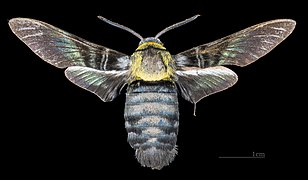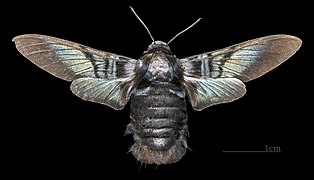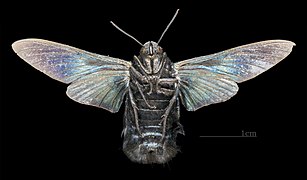Sataspes tagalica
Appearance
| Sataspes tagalica | |
|---|---|

| |
| From Lionel de Nicéville's 1900 "On new and little-known Lepidoptera from the Oriental region" | |
| Scientific classification | |
| Domain: | Eukaryota |
| Kingdom: | Animalia |
| Phylum: | Arthropoda |
| Class: | Insecta |
| Order: | Lepidoptera |
| Family: | Sphingidae |
| Genus: | Sataspes |
| Species: | S. tagalica
|
| Binomial name | |
| Sataspes tagalica | |
| Synonyms | |
| |
Sataspes tagalica, the brilliant carpenter-bee hawkmoth, is a species of moth of the family Sphingidae first described by Jean Baptiste Boisduval in 1875.
Distribution
It is known from western and north-eastern India, Nepal, Myanmar, eastern and southern China and Thailand.[2] The habitat consists of woodland margins and shady tracks through woodland, particularly near bodies of fresh water.
Description
The wingspan is 56–70 mm. It is a variable species with several named forms. It is a mimic of Xylocopa carpenter bees, with males and females mimicking different species.
-
Male dorsal view
-
Male ventral view
-
Female dorsal view
-
Female ventral view
Biology
It is a day-flying species. Adults are attracted to the flowers of Duranta erecta and Lantana camara.
The larvae have been recorded feeding on Dalbergia benthamii in Hong Kong.
References
- ^ "CATE Creating a Taxonomic eScience - Sphingidae". Cate-sphingidae.org. Retrieved 2011-11-01.[permanent dead link]
- ^ Pittaway, A. R.; Kitching, I. J. (2018). "Sataspes tagalica tagalica Boisduval, [1875] -- Brilliant carpenter-bee hawkmoth". Sphingidae of the Eastern Palaearctic. Retrieved December 17, 2018.




